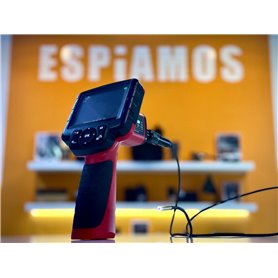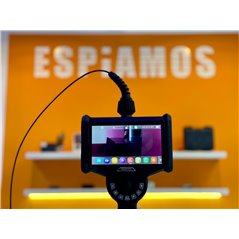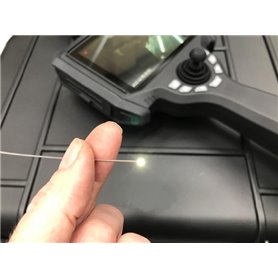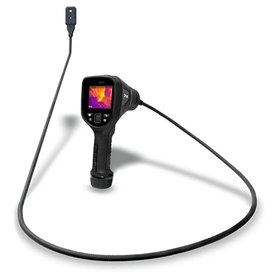C/ Duque de Sesto 13
28009 Madrid
Madrid
Spain




4 products
Active filters
Endoscope Cameras: Precise and Versatile Inspection Technology
Borescopes and visual inspection devices are essential tools for reviewing hard-to-reach spaces, making them indispensable in industries like construction, automotive, and security. Thanks to their flexible design and the high image quality they offer, these devices allow for the detection and resolution of problems in areas that would be inaccessible without invasive interventions. This type of inspection camera provides real-time images that are vital for identifying structural defects, malfunctions, or even for conducting covert surveillance tasks. Additionally, many advanced models include features like adjustable LED lighting or wireless connectivity, which enhances their versatility. Whether you're looking for a WiFi borescope or a specialized model like a professional endoscope, our store offers a wide range of solutions to meet your needs.
Professional Uses of Endoscopes
The use of flexible inspection devices has expanded across various industries due to their ability to perform non-invasive visual inspections. In the automotive sector, for example, a visual inspector for engines is ideal for checking the internal condition of cylinders or engine components without needing to disassemble parts. In construction, pipe inspectors help locate leaks or blockages without needing to drill through walls or floors, saving both time and resources. In the field of security and surveillance, these devices are used for the discreet monitoring of restricted or hazardous areas. A professional borescope can be extremely helpful for inspecting ventilation ducts, air conditioning systems, or any other confined space, making these devices essential tools for investigators, technicians, and security agents.
Key Features of Borescopes and Endoscopes
When choosing a high-resolution visual inspector, it is important to consider several key features. First, the length and flexibility of the cable: depending on the work area, you may need a long-cable borescope to reach deeper areas. Second, the camera's resolution: a Full HD endoscope guarantees sharp and detailed images, which is essential for identifying specific issues in the inspected area. Additionally, most wireless borescopes are equipped with WiFi or Bluetooth connectivity, making it easy to view images in real-time directly on mobile devices or tablets. This feature is especially useful when working in teams, as it allows images or videos to be shared without the need for cables. Some advanced models even include video recording and image capture, making them ideal for documenting evidence or conducting later analyses.
Benefits of Using Borescopes and Inspection Cameras
Using borescopes and other inspection devices provides multiple advantages across various sectors. One of the main benefits is the ability to access confined or hard-to-reach spaces without needing to disassemble or drill, significantly reducing the time and costs associated with repairs. Additionally, a flexible borescope allows for quick and precise inspections, adapting to curves and obstacles—essential in places like pipes, ducts, or mechanical compartments. Another key advantage is the ability to record and document the entire inspection process. Endoscopes with recording capabilities allow you to capture high-resolution images or videos, which are crucial for documenting potential damages or faults, making them ideal for audits, maintenance reviews, or even evidence for legal disputes. This capacity to record visual evidence can be a valuable resource in legal proceedings, especially in cases related to structural defects or machinery problems. Finally, the most recent models, such as portable endoscopes, offer the advantage of being easily transportable, making the work of technicians, inspectors, and security professionals easier. Their compact design ensures you always have an effective inspection tool at hand, ready to be used in any unforeseen situation.
Differences Between Types of Inspection Devices
There are several categories of borescopes and industrial endoscopes designed to meet different requirements depending on the type of application. Among the most common are rigid borescopes and flexible borescopes. Rigid models tend to be more robust and are used in scenarios where the inspection is carried out in straight lines or without many turns. In contrast, flexible models are ideal for inspecting pipes or ducts with multiple bends, as they provide greater maneuverability. Another important distinction is between inspection cameras with a built-in screen and wireless cameras. Devices with their own screen allow you to view images directly on the device, which is useful for quick inspections. However, wireless endoscopes with WiFi or Bluetooth connect to smartphones or tablets, providing greater flexibility and remote control, along with the ability to view and share images remotely. For users seeking the highest image quality, 4K endoscopes are available, offering extremely detailed resolution. This option is particularly suited for professional applications that require the detection of tiny defects or comprehensive visual analyses.
Tips for Choosing the Best Borescope or Endoscope
When selecting the inspection device that best suits your needs, it is essential to consider a few key aspects. First, the length and flexibility of the cable, as these will determine how far you can access the areas to be inspected. If you work in deep or hard-to-reach spaces, a model with a long and highly flexible cable will be your best option. The image quality is another crucial factor. A high-definition visual inspector will allow you to obtain clear and precise images, which is essential for detecting specific faults or damage. Additionally, it is recommended that the device has adjustable lighting to improve visibility in dark or hard-to-reach areas. Borescopes with adjustable LED lights are ideal for these scenarios. Finally, if you need to easily share images or videos, opt for a wireless borescope with WiFi or Bluetooth connectivity. This not only makes it easier to view images on mobile devices but also allows you to share data with other team members, making the entire inspection process more efficient.
Advantages of Using Inspection Cameras with Connectivity
WiFi inspection cameras and wireless borescopes have revolutionized the way inspections are conducted, allowing professionals to work with greater freedom and comfort. By connecting wirelessly to smartphones or tablets, these devices offer real-time viewing without the need for cables, making it easier to work in spaces where mobility is limited or where quick movement is required. This type of connectivity not only improves the user experience but also allows images or videos to be shared instantly with other team members or clients, which can be vital in collaborative work or technical report presentations. Some advanced models even allow remote control of the device, making handling in hard-to-reach areas or situations requiring maximum precision even easier.
Frequently Asked Questions (FAQs)
What is a borescope and what is it used for?
A borescope is a visual inspection device designed to access confined or hard-to-reach areas. These devices are widely used across various sectors, such as automotive, construction, engineering, and security. Their main purpose is to enable visual access to spaces that would be impossible to reach with the naked eye, without having to dismantle equipment or structures. Thanks to their miniature camera and flexible or rigid design, borescopes are ideal for detecting problems, performing preventive maintenance, or conducting detailed inspections of machinery, engines, pipes, and more.
What are the differences between a borescope and an endoscope?
Although the terms "borescope" and "endoscope" are often used interchangeably, there are key differences between these two devices. Borescopes are more oriented towards industrial applications, such as inspecting engines, ducts, or complex mechanical systems. Endoscopes, while also used in industry, are more closely associated with medicine and the internal inspection of living organisms, such as humans and animals. Borescopes are generally more robust and durable, capable of withstanding harsh industrial environments, whereas medical endoscopes are more delicate but offer greater precision in imaging and maneuverability for extremely tight spaces.
What length of cable is best for a borescope?
The length of a borescope's cable will largely depend on the application for which it is being used. If you need to inspect deep or extensive areas, such as long pipelines or ventilation ducts, a borescope with a long cable, between 5 and 10 meters, will be the best option. For simpler and short-distance inspections, such as inside an engine or small spaces within a structure, a 1 to 3-meter cable will suffice. Additionally, it's important that the cable is flexible and of high quality to ensure easy maneuverability in tight and curved areas.
Can I connect a borescope to my smartphone?
Yes, many modern borescopes are equipped with WiFi or Bluetooth technology, allowing them to connect easily to a smartphone or tablet. This not only facilitates real-time viewing of the images but also offers the option to record videos, take photos, and share the information instantly with other devices. This feature is particularly useful when working in teams, as multiple people can view the inspection at the same time. Additionally, by connecting the borescope to your smartphone, you can control some of the device's functions directly from the app, providing greater convenience and efficiency during the inspection.
What is the best resolution for an inspection device?
The camera resolution is one of the most important aspects to consider when choosing a borescope or endoscope. For basic inspections or routine maintenance tasks, a standard resolution of 720p or HD is sufficient for viewing medium-sized areas and detecting obvious problems. However, if you need greater precision or are working in environments where defects or faults may be very small (such as in mechanical components or micro-ducts), a borescope with Full HD (1080p) or even 4K resolution will be the best option. These resolutions allow you to capture very fine details, which is essential for performing thorough analyses and making informed decisions during repairs or diagnostics.
Do borescopes have built-in lights?
Yes, most borescopes come with built-in LED lights that allow you to illuminate dark areas you access during the inspection. These lights are adjustable in intensity, enabling you to increase or decrease the brightness depending on the conditions of the environment in which you're working. Having proper lighting is crucial for obtaining clear images and detecting any problems with precision, especially in dark ducts, enclosed engines, or spaces with limited visibility. Additionally, some advanced models offer the option to change the color of the LED light, which helps highlight certain details on different materials or surfaces.
Is it possible to record videos with a borescope?
Yes, many modern borescopes include a video recording feature, allowing you to document the entire inspection in real time. This function is extremely useful for generating detailed visual reports, whether for technical use, later analysis, or as evidence in audits or legal proceedings. By capturing both video and still images, you can review and analyze the information later, which is ideal for complex diagnostics. Additionally, some borescopes allow you to store these files directly on a memory card or transfer them to other devices via WiFi or Bluetooth, making it easier to create professional reports or track the status of a repair over time.
What is a borescope used for in the automotive industry?
In the automotive industry, borescopes are indispensable tools for performing internal inspections without the need to disassemble vehicle components. They are commonly used to inspect the inside of engines, cylinders, exhaust systems, ventilation ducts, and other mechanical parts. Thanks to their miniature camera and flexible cable, mechanics can detect issues like wear, blockages, or damage in internal areas without having to dismantle the entire system, saving both time and costs. Additionally, borescopes are useful for verifying previous repairs or conducting thorough evaluations before making more invasive adjustments to the vehicle.
What are the differences between a rigid and flexible borescope?
Rigid and flexible borescopes differ mainly in how they can be maneuvered during an inspection. Rigid borescopes have a fixed tube and are better suited for inspections in linear areas or without many curves, such as inspecting inside a straight pipe or duct. They are more robust and provide greater stability in the images. Flexible borescopes, on the other hand, are designed to adapt to curved or obstructed areas, making them perfect for inspecting winding pipes, engines with many moving parts, or complex ventilation systems. The choice between a rigid or flexible model will depend on the type of application and the work environment.
Are borescopes waterproof?
Some borescopes are designed to be waterproof and can be submerged in liquids, making them ideal for inspecting pipes, sewers, drainage systems, or other wet areas. To know if a borescope is suitable for working in water-rich environments, it's important to check its IP rating, which indicates the device's level of resistance to water and dust. A borescope with an IP67 rating, for example, will be water and dust-resistant, making it suitable for inspections in challenging or dirty environments. However, it is always recommended to check the manufacturer's specifications before submerging the device to avoid damage.
check_circle
check_circle






 WhatsApp
WhatsApp Telegram
Telegram






